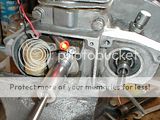Re: Bench Test of CDI
Here's a quick way to bench test a CDI module, be careful, HIGH VOLTAGE.

I like it.....
The magnet (itself) has nothing to do with weather the Magneto (coil) will fire or not (although you need it). It's just a magnet mounted on the shaft, opening and closing the field. When was the last time one saw a magnet go bad. If you want to check it, take a screwdriver and touch the magnet itself. My first suspect would be in the timing of the engine. These are very simple engines, easily to diagnose problems.
What I would do, but that's me.
1. Disconnect the kill wire switch. Still no spark?
2. Make sure the the electrical connections are correct. This includes removing the white wire completely. Re solder the blue wire (cold solder joint), and at the same time check the timing (broken key), make sure the blue wire is not grounding anywhere. Check the wires themselves. Check the terminal, make sure it has a good ground contact on the magneto. on the black wire
3. Checking engine timing...
Magnetto pictures by Ron-Becker - Photobucket
4. I made a small LED test light to see if the magneto puts out voltage. Bought at Radio Shack


5. Then on to the CDI and check as Tom described.
6. The spark plug or wire might be defective. Check them also.
7. Then I'd replace a part, as needed.





